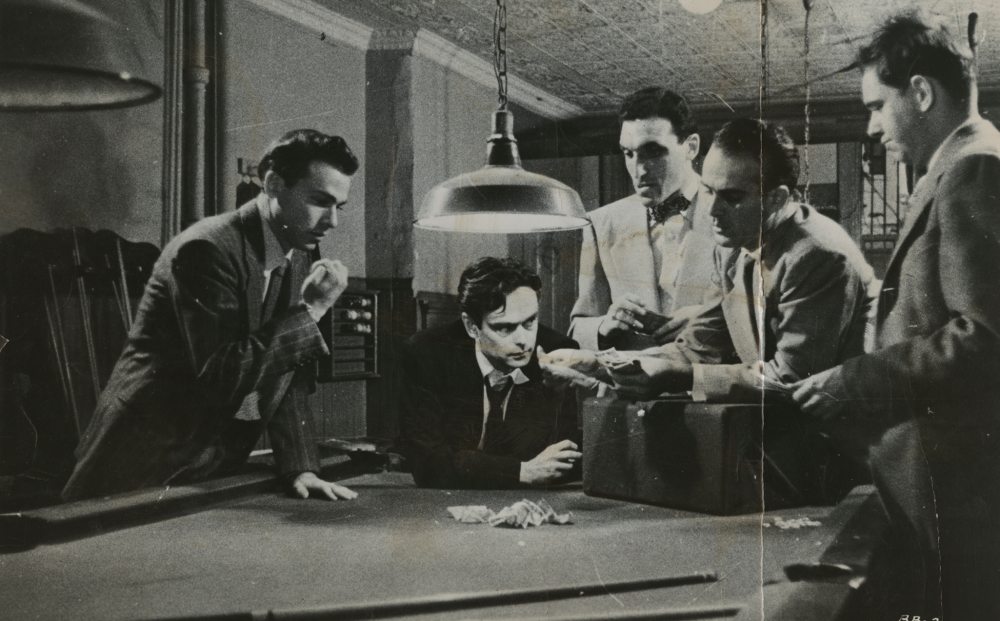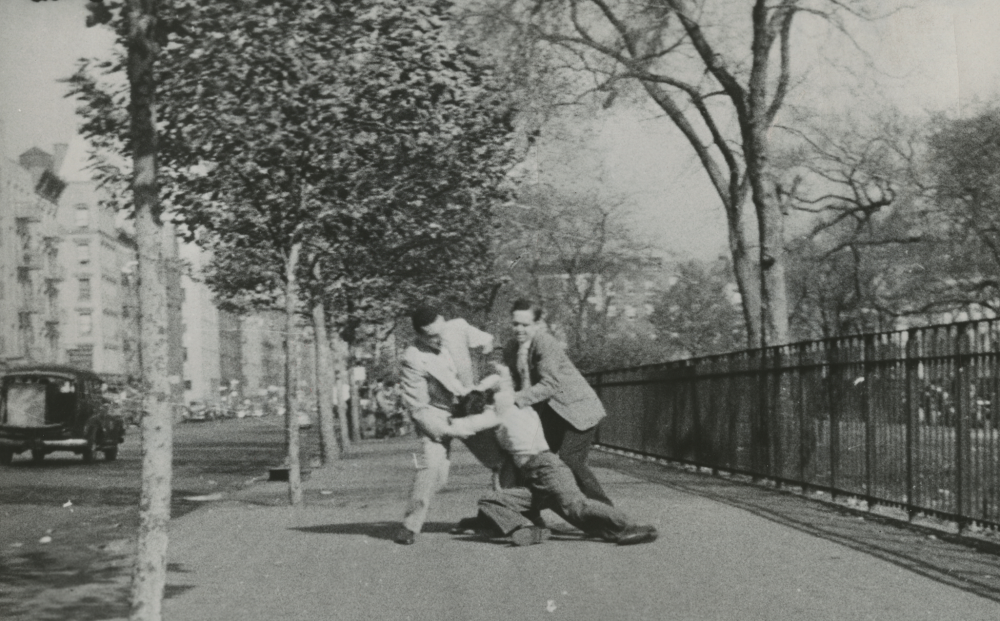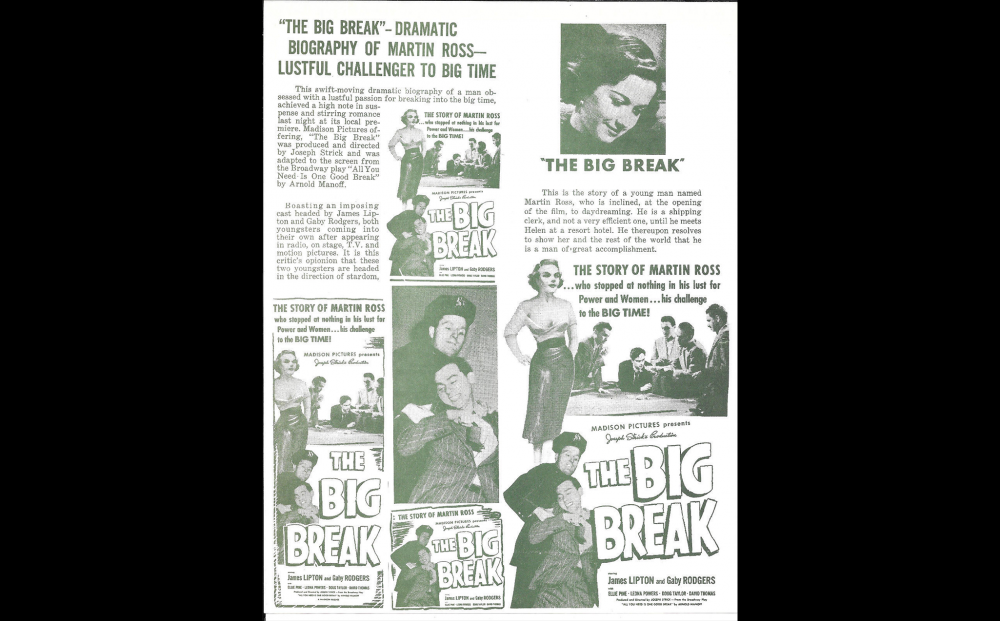THE BIG BREAK
U.S., 1953
Directed by Joseph Strick
With James Lipton, Gaby Rodgers, Ellie Pine
Approx. 75 min. Digital.
'The Actors Laboratory Theatre, a left-wing theater company and acting school in Hollywood, had mounted a showcase production of Arnold Manoff’s All You Need Is One Good Break in July 1948. The run was successful enough to attract Monte Proser and Joseph Kipness, the investors behind the musical hit High Button Shoes, who brought an expanded version to Broadway in February 1950. The show soon folded in New York (Times theater critic Brooks Atkinson dismissed it as “meaningless and obsolete”) but Joseph Strick quickly picked up the film rights for $2500. Based in Los Angeles, Strick had made films for the Army Air Corps during the war, and with Irving Lerner had produced an interesting local documentary, Muscle Beach, in 1948. He had the script of THE BIG BREAK (as he now called it) entirely rewritten, downplaying the political content and de-ethnicizing the main character, whose name changed from Rothman to Ross. The cast consisted entirely of unknown New York actors: James Lipton (later the host of “Inside the Actors Studio”) shares top billing with Gaby Rodgers (already employing the fine Bronx accent she uses in her only other film role, Lily Carver in Robert Aldrich’s KISS ME DEADLY). Strick’s version retained the original’s proletarian ambiance, but the hero was now more of a dreamer than the “tenement wastrel” who had so annoyed Brooks Atkinson. The story became, “the intimate narrative of two young people whose dreams far exceed their probability of attainment,” and whose relationship is sorely tested after a series of melodramatic episodes.
Strick is best known today for THE SAVAGE EYE (1960), which followed its disaffected heroine around a sharply etched city of Los Angeles. But at least one critic saw him doing the same thing here. “Most of the sets for this production are the streets, parks and buildings of New York,” Motion Picture Daily reported, praising its “realistic photography,” and the way Strick captured “the flavor of a youngster working as a shipping clerk in the garment center.” Production began on October 16, 1950 at Camp Fieldstone in Monroe, New York, where the Lipton and Rodgers characters meet cute at the Ramapo resort. Clearly deserted so late in the season, Fieldstone apparently provided accommodations in exchange for some heavy product placement. According to the Times, which devoted a column to the start of production, Boris Kaufman was behind the camera, which would have made this his first American feature. But Kaufman seems to have been replaced by Bill Miller early enough for Miller to earn sole credit. Although produced on a budget of “under $100,000,” Strick was not scrimping on the camera crew here; Kaufman and Miller were the top first cameramen in New York and the result was far more professional than the typical independent feature. Sound recording was also remarkably sophisticated, nearly all of it done directly on location, even on interiors.
THE BIG BREAK wrapped as scheduled on November 10, 1950 and was approved by the Production Code Administration two months later. But like many other self-financed films that risked going into production without a distribution deal, the picture just sat on the shelf. Strick finally turned it over to Jack Rieger’s Madison Pictures in September 1952, which offered it to low-end theaters needing something to fill out the bottom half of their double features. The film did earn a few scattered commercial bookings, but the only reviews I could locate were the obligatory notices from trade papers. Although copies of the film are held by at least two American archives, The Big Break disappeared from public view soon after its original release and has been almost completely forgotten. While not without its problems, Strick’s film is interesting for the way it roots its coming of age narrative in the changing cultural and economic landscape of post-war Manhattan. In many ways it might even be said to prefigure the next generation of local indies, especially films like SOMETHING WILD, THE SMALL HOURS or THE GREENWICH VILLAGE STORY, all released between 1961 and 1963. Stanley Kubrick, after finishing production of FEAR AND DESIRE in 1952, was also stuck without a distributor. But Kubrick was either luckier than Joe Strick, or simply more patient. By holding on long enough he avoided Jack Rieger and managed to sell his picture to Joseph Burstyn instead.' – Excerpted from “Keep ‘em in the East”: Kazan, Kubrick and the Post-War New York Film Renaissance by Richard Koszarski (Columbia University Press)
With support from the Robert Jolin Osborne Endowed Fund for American Classic Cinema of the 1930s, ‘40s, and ‘50s and the Ada Katz Fund for Literature in Film.



